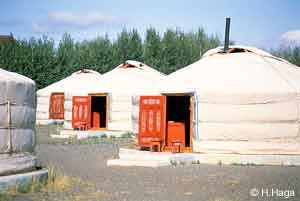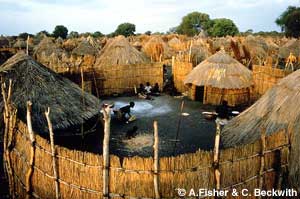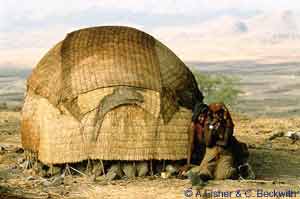|
|
Return to Top Page |

Ondol (Heated Floor during Winer) Suwon, Korea Ondol is the traditional under floor heating system which has been used in Korean peninsula where the winter is very severe. The heat from the stove in the kitchen goes through the pathway under the floor. They used to use the firewood or straw for the stove. The entrance of the house is made smaller to prevent cold air coming into tht house. They sleep on the warm floor with the mat and they do not need to wear room shoes. In the modern Korean house, Ondol is still used by hot water instead. |
 South Gobi Desert, Mongolia Gel is the Mongolian transferable nomad house. They move the house when their domestic animals have eaten the grass in that area. The main 2 poles in the center support the house with the framework. They cover the framework with the white cloth filled with wool and hair of the domestic animals. In the center, they place the stove and the ceiling can be opened for the smoke. During the severe winter, they make double cover on the ceiling. |
|
|
|
||

Stone Houses of Miao Tribe Guizhou, China In Miao village, the houses are built with stones. There are many lime stone caves in this area. The topographical feature here is called eKarst' where the stones contain a lot of calcium carbonate. |
 Fujian, China In dry Fujian area, the houses are built with the hard solid soil walls. The houses were built about 300 years ago. Hakka family was moving from the Yellow River area in 12 th to 13 th century. They build the many town houses surrounded by the hard walls to protect from the outsiders. The houses are 4-storied and hundreds of people are living together. One townhouse is for the whole family who has the same last name. The other family or not Hakka family are not allowed to live. |
|
|
|
|
|

Tree House of Bagobo Tribe Mindanao Island, Philippines The people in the south of Philippines used to live in the tree houses. From the tree houses, they could find the enemies, the poisonous snakes and wild animals. They also could get the cooler and drier air. The houses are needed to rebuild as the trees grow. The tree houses are now used for the meeting and resting. |
 Sabah, Malaysia The fishermen in Saba of Borneo Island live on the water. In the water village, there are so many houses still now. They use the timber of mangrove tree which has the durability against the sea water to build the water house. The water houses are officially issued the addresses and the family registrations. |
|
|
|
|
|

House of Lafu Tribe Norhern Region, Thailand In the Village of Lahu Tribe, nearly 5,000 people live in the houses on the steep land 1,000 meters above sea level. The floor of the house is 2 meters high and under the floor, they keep cow, pigs and chicken. They made house with the wood panels crossing each other.
|
 Merzouga, Sahara Desert, Morocco In southern part of Morocco, the houses are made of the bricks. They mix some water with clayey soil and put them into the mold to dry under the Sun. They use the clay to paste bricks one by one and then, paste the clay over the bricks to build the house. The bricks can keep the room temperature at comfortable level, even the outside temperature is changing drastically during a day. However, the houses are not strong for earthquake. |
|
|
|
||

Anuak Tribe Village Omo Valley, Ethiopia Anuak people are living in northwest part of Omo valley. They build their own houses by family and gather in the village. In the center of the village, they grind corn into flour to cook rice porridge. |

Eritrea Afar people are nomad living in Great Rift Valley. Their house is called Bulla which is transferable compact dome shaped house. The house is made of straw which is easy to carry. |
|

Old Town Sana'a, Yemen The name of this building means rock castle which was build in 1930. This tall building is made of bricks and painted white on the window frames. The bricks are made from the mixture of clay, soil and straw which could be kept for over 500 years. |
 South Africa Ndebele women paint colorfully with the original geometrical pattern on the wall of their houses. These beautiful patterns of paintings are their own expression and handed down from a mother to a daughter. They have a keen artistic sense of beauty which shows in their traditional cloths as well. |
|
|
|
||

Reed Houses of Uros Tribe Titicaca Lake, Peru Lake Titicaca is nearly 400 meters above sea level. About 2,000 Uros people live on about 50 artificial reed Islands made of floating reeds in the lake. They make living by fishing and tourism. The island, boats and houses are all made of reed. They have to pile fresh reed over them every several months as the old reed is decaying. They started to live in this way as they escaped from Spanish army about 500 years ago. |
 Alberta, Canada Tepees are the transferable cone shaped house of Native American who move to live for hunting. When they move, they carry the poles on the horses. The house is 3.5 to 5.5 meters high and there is the exhaust pipe in the center of the house. The house is covered by buffalo hide. In these days, they use campus cloth in stead. They only use them when the festival is held. |
|

Wooden Frame Houses Rheinland-Pfalz, Germany The wooden frame houses are very popular in Germany. They use the bricks for the wall and paint over the bricks which become very strong and last for hundreds of years. The wooden frames make them possible to have many windows. |
 Santorin Island, Greece The entrance of the Island is fully filled with the white houses on the cliff. The Island used to be an active volcano and the eruption around 1500 B.C. created this unique shape of the Island. |
|
|
|
||

Cueba (Underground Houses) Andalucia, Spain In Andulucia of south Spain, the underground house, eCueba' could keep cool inside even it is over 40 degrees outside and keep inside warm during the winter. |
 Rovaniemi, Finland Sami people of North Finland are nomad and they move their houses in summer and in winter. In their winter houses which are made of wood and clay, they use fire to keep them warm. In summer, they live in transferable houses looks like the ones of Native American. |
|
|
Return to Top Page |
|